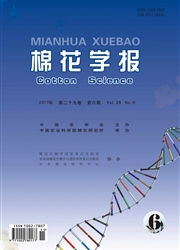

 中文摘要:
中文摘要:
为建立适合于SSR标记的棉花品种纯度鉴定方法,利用78个SSR标记对12个棉花常规品种进行标记基因型分析。通过比较不同品种不同单株标记基因型,发现棉花品种的非纯SSR位点存在3种主要类型。通过综合分析非纯SSR位点率和异型单株率对品种遗传纯度的影响,建立了利用SSR标记在分子水平上鉴定棉花品种纯度的方法。利用该方法鉴定的12个棉花品种中有3个品种(C5、C9和C11)的遗传纯度在98%以上,非纯SSR位点和异型株均较高的2个品种(C3和C6)遗传纯度分别为67.31%和31.79%.该方法弥补了以往分子纯度计算方法中只考虑单株混杂、不考虑SSR位点混杂的缺陷,可比较客观地反映品种的遗传纯度状况。
 英文摘要:
英文摘要:
To establish a method for genetic purity identification of cotton (Gossypium hirsutum L.) varieties by SSR markers, marker genotypes of 12 conventional cotton genotype varieties were surveyed using 78 pairs of core SSR primers. By comparing SSR loci from different individuals of all tested cotton varieties, the non-homozygous SSR alleles of cotton variety were divided into three typical scenarios at the molecular level. Consequently, a method for the genetic purity identification of cotton varieties using SSR markers was proposed based upon analysis of the comprehensive influences of both non-homozygous SSR loci and the rate of heterotype individuals in the cotton varieties. For the genetic purity of 12 cotton varieties tested by this method, three varieties (C5, C9 and C11) were above 98%, while two varieties (C3 and C6) were 67.31% and 31.79%, respectively. The method proposed takes into account both the influences of farraginous individuals detected by SSR markers and the inherited non-homozygous SSR loci on the purity of a cotton varieties, and therefore, provides an effective and reliable way to identify the uniformity and stability of cotton varieties.
 同期刊论文项目
同期刊论文项目
 同项目期刊论文
同项目期刊论文
 期刊信息
期刊信息
